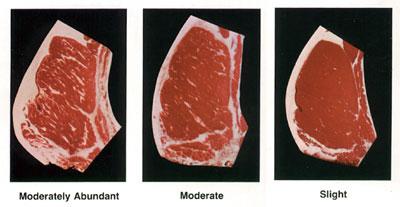Fat is Not Always a Bad Word
Is fat a bad word? Not necessarily. Simply put, fat is just the body’s storage form for energy. If an animal consumes more energy than it uses, their body will store the excess calories as fat—like money in the bank they can use in an energy shortage (think cows calving in late winter). Fat imparts flavor to food (like a T-bone steak) but it also adds calories. So managing fat can be a delicate issue in the cattle business.
Presently, the quality of beef is estimated to a large degree by the amount of marbling (intramuscular fat) that it contains. Tenderness is also important but is generally a function of age; younger is better. Marbling generally increases after the animal attains some maturity and external fattening has occurred. External fat is frequently used as an indication of when cattle will have enough marbling to grade choice or prime.
So, why don’t we just measure marbling? We’re getting to that with ultrasound technology, and it would allow us to avoid over-finishing fed cattle. Ideally, marbling would occur in feedlot cattle with very little external fat being present. We would like to have Choice and Prime quality grades with yield grades of 2 or 3 for our fed cattle. But if we bred cattle to meet this criterion, it could have a negative effect on the beef cow herd by potentially taking away fleshing ability, which could have a negative effect on reproduction.
It is important to understand how cattle fatten so that we can manage them accordingly. Fat is “laid down” from front to back and top to bottom. The fore ribs and spinous processes, the bony projections on top of each vertebra, are covered first, then the fat cover continues backward and downward. That’s why folks look for cod fat (in the scrotal area) as an indicator of when cattle are finished. It is the last place to fatten. Loss of body fat happens in reverse order. Fat cover is the basis for condition scoring in beef cattle.
Body condition has a definite impact on reproductive performance. Cows should generally be at a Body Condition Score (BCS) of five at the beginning of the breeding season. A cow with a BCS of five will have some fat reserves, with fat cover over all the ribs. As cows lose condition, a BCS of five would become a BCS of four when there is no cover over the last two ribs. This would mean that the cow has very marginal energy reserves for good reproductive performance. If this loss of condition continues so that you can see the foreribs (BCS three), then you have a real problem. Conception rates will suffer.
You generally see a loss of condition after calving when dietary energy needs have dramatically increased and the feed you supply isn’t meeting those needs. The cow has to “withdraw energy from her bank” to meet her nutritional needs. It is important that some energy reserves are available.
And what about the herd bulls? Bulls need some energy reserves so they can stay active during the breeding season, but bulls are athletes and need more than just fat. They should have muscling, sound feet and legs, and they should be able to sire a large number of calves in a short period of
Managing fat, or body condition, is important in the cattle business, especially in the cow herd for optimum reproduction. Fat is important—both too much or too little can be a problem. Astute producers recognize the importance of efficient cattle that can maintain adequate energy reserves without wasting feed resources.
For more information, contact the Butler County Extension Office at 112 E GL Smith Street, Morgantown, or call 270-526-3767.
Educational programs of the Kentucky Cooperative Extension Service serve all people regardless of race, color, age, sex, religion, disability, or national origin.
By: Greg Drake II, County Extension Agent for Agriculture and Natural Resources
- Log in to post comments



























